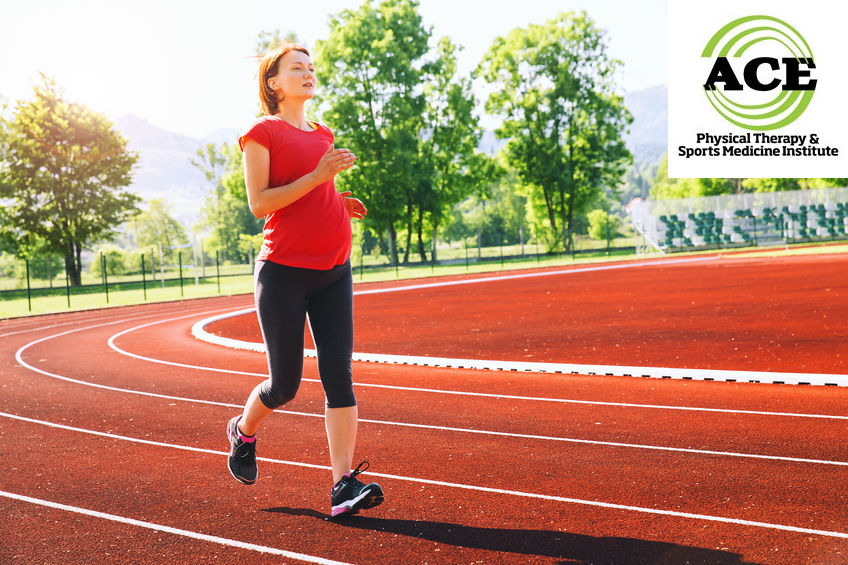PREGNANT ATHLETES AND COMPETITION

Tid Bits of Info
- Current guidelines support continued exercise throughout pregnancy.
- Low back and pelvic pain are some of the most common complaints of pregnant women.
- Resting heart rate can increase 15-20 beats per minute as pregnancy progresses.
- Athletes have reported less low back and pelvic pain which can be linked with more strength and better dynamic stability.
- Seek the advice and treatment from a Physical Therapist if you are pregnant and want to continue a modified exercise routine.
In recent years, several high profile pregnant athletes have competed and won in sports such as tennis, volleyball, curling, and even the 800 meter run. This high level competition by pregnant athletes was unheard of just 15 years ago. Today many athletes have continued competing while pregnant or returned to competition shortly after giving birth. Proper monitoring and training are keys for continuing athletic competition during pregnancy.
While there have been a variety of studies on pregnant athletes, there are still many questions about safe training exertion levels that will protect the athlete and baby. It is important to remember that most of these guidelines are being set for the person who has an uncomplicated pregnancy. Ultimately, the female athlete and her doctor must determine the level of exertion that is safe for everyone involved.
The female body goes through tremendous change during a pregnancy! Most guidelines for exercise during pregnancy are based on uncomplicated pregnancies and “normal” healthy woman with no risk factors. These guidelines do not take into account the increased intensity that a competitive female athlete might train or compete during their pregnancy. The guidelines have not been well established for particular activity level for the different trimesters of pregnancy. Obviously more detailed research must be performed to establish accurate guidelines that protect the athlete and the unborn child.
Besides the cardiovascular system changes that occur throughout a woman’s pregnancy, there are a number of musculoskeletal changes that can lead to a host of orthopaedic problems that cause pain and limit activity level. Obviously, the spine and pelvis are the primary sites of change and can experience excessive forces that are totally foreign to a woman’s body prior to becoming pregnant. As the pregnancy progresses, the lumbar spine becomes more curved (hyper lordosis) which shortens the gluteal muscles and leads to weakness. The anterior musculature in the abdominal wall is stretched and becomes weak, also. Couple all of the weakness with a hormonal change that prepares the body for the delivery by “loosening” the ligaments and the pelvis and lumbar spine are pre-disposed to suffering an injury. Low back and pelvic pain are some of the most common complaints of pregnant women. It has been reported that up to 45% of all pregnancies lead to this condition. Athletes tend to experience less frequency of low back and pelvic girdle pain, and it is hypothesized that they begin their journey through pregnancy at a higher level of strength and lumbar spine stability compared to the non-athlete. It supports the practice of exercising throughout a pregnancy.
Whether prepping for competition or seeking to remain in “playing shape,” pregnant athletes should monitor several key physiological functions during exercise. Cardiovascular status should be maintained at approximately 75-80% of their maximum heart rate. Respiratory rate should never go above 90% of the VO2 maximum. Pregnant athletes should avoid exercising in extreme heat or humidity to avoid “over-heating” internally.
Musculoskeletal injuries are some of the most common issues that pregnant athletes have to treat. One way to attempt to avoid these injuries is to be sure the muscles are providing dynamic support to the joints in a particular area. The routine should begin with exercises that are designed to activate the pelvic floor muscles. The core musculature, the lower abdominal musculature in particular, needs to be active and able to respond when the athlete moves. Once these muscle groups are active and functioning properly the larger muscles surrounding the lumbar spine and pelvis can be strengthened.
Seeking the advice and treatment of a Physical Therapist for a proper exercise routine is recommended. These healthcare professionals can develop an exercise program that will help the pregnant athlete exercise safely and protect themselves and the unborn baby. Maintaining adequate strength, muscular endurance and proper neuromuscular activation is critical for the athlete. This enables the joints to be moved efficiently and be dynamically supported to offer protection and help to avoid an injury. Lifting weights has been shown to be beneficial but the amount of weight lifted should be monitored. There are some studies that indicate that the total amount of weight lifted is more important to monitor than the number of lifts per exercise session.
Exercise has been shown to have very positive effects on pregnancy and it appears that there is no reason for athletes to stop participating in their sports when they are pregnant providing they use caution and monitor the intensity of their workouts.
